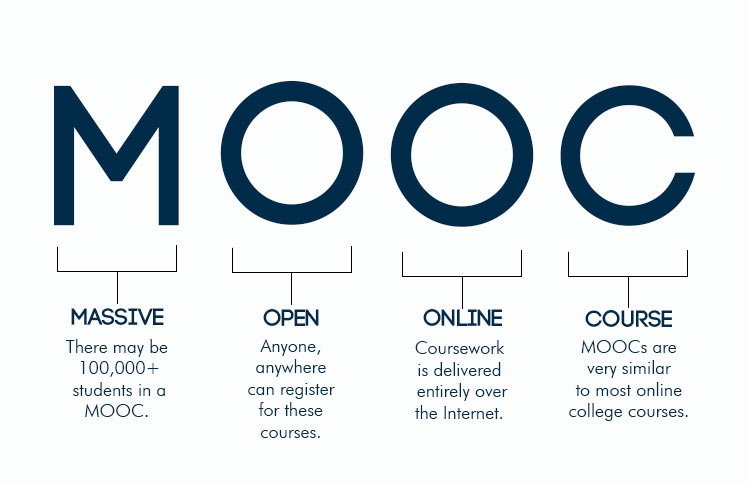Learning From MOOCs - Tonya Michael - January 9, 2018 - EDDH 640 Technology and Revolutions in Higher Education - Dr. Cedrick D. Gilbert

MOOCs have open scrutiny from several different aspects including design, delivery, and outcomes from other colleges, business, and individuals. MOOCs fit in the general higher education landscape MOOCs are massive, open, online courses used to grant open access to the public for little or no cost. MOOCs are used by students and professionals to gain knowledge about their professions. Some count for credit in classes, professional development points, or for general knowledge and growth. “For those who are driven and can self-motivate, they can be an excellent way to refresh knowledge, learn new skills, or to simply engage in a topic of interest on a nearly limitless array of topics” (Learning Technologies, 2015).
MOOCs should not be used for credit based courses, because 95 percent of the students that signed up for a class did not complete the course (Haber, 2014). In the general higher education landscape, the teachers can utilize MOOCs by adding a level of responsibility with using the courses. Teachers can have the students to require a certification of completion from the site and a summary to go with the course. Accountability and usability are two important results from integrating MOOCs effectively.
Institutions would need to either give required courses or a choice of options that have been reviewed and approved by the professor before incorporating MOOCs into the class. This will ensure the materials are valid, the students will have insight to topics the class is learning about, and it will provide the students with additional resources for learning. We have used training mocks for professional development. Another way to measure the quality is to have a questioning built into the MOOCs, and have the students to have to make a specific score before earning credit for the course. For the courses to be credit bearing, the MOOCs should not stand alone as criteria for credits. The institution should require a specific amount of MOOCs, specific scores, and time limitations for the MOOCs to be used as credit. Due to the lack of oversight, MOOCs are not likely to be credit bearing, but it would be used as an additional resource unless the progress is monitored by a professional and examined for quality outcomes (Learning Technologies, 2015).
Reference:
Haber, J. (2014). MOOCS. Cambridge, MA: The MIT Press.Learning Technologies. (2015, November 23). 5 Questions: What You Need to Know About MOOCs. In Learn Tech. Retrieved January 9, 2018, from: http://www.codlearningtech.org/2015/11/23/5-questions-what-you-need-to-know-about-moocs/
Selingo, J. J. (2014, October 29). Demystifying the MOOC. The New York Times. Retrieved from http://www.nytimes.com/2014/11/02/education/edlife/demystifying-the-mooc.html
Tonya,
ReplyDeleteBlogging allows for enhancing and supporting meaningful communication by providing a web platform that allows users an easy way to create, update, and publish content. Blogging also allows readers of the blog an opportunity to respond to the author, thus providing an interactive conversation between the author and the reader. What are your thoughts?
Dr. G
Hello Tonya,
ReplyDeleteYour post was relevant and helpful in discussing the subject of MOOCs. I agree that persons who are highly motivated with a drive to learn will benefit the most from MOOCs. However, I wish to differ in the claim you made that “MOOCs should not be used for credit based courses, because 95 percent of the students that signed up for a class did not complete the course.” While it is true that a large number of students did not complete the course, what about the percentage that did complete the course? If the courses are the same ones taught in the on-campus classroom by the professor, then it should be accepted for use the MOOCs platforms. In Nafukho & Irby (2015) explained how “some colleges and universities have a practice of accepting MOOCs for credit with approval of a faculty senate or an approved department within a college or university,” giving the example of Georgia State University which is considering “how they would grant credit for MOOC courses” (p. 241). I believe MOOCs enrich higher learning.
Thanks for your pertinent post.
Levi
Reference
Nafukho, F. M. & Irby, B. J. (2015). Handbook of research on innovative technology integration
in higher education. Hershey, PA: IGI Global.
Hello Tonya,
ReplyDeleteI believe that MOOCs can be utilized for credit-based courses. If the MOOC course is attached to the main class as a lab with a P or F grade in the same manner as a science lab it could work. Depending on the subject matter, MOOCs can enhance the learning experience of the instructor course. The student must be required to finish the MOOC course by the end of the semester in order to receive the grade and that would show up on the student’s transcript.
MOOCs must be approved by the faculty senate or the governing body of the institution. Faculty resistance can hinder new technologies which can prevent future benefits for the university (Bastedo, Altbach, & Gumport, 2016). Institutional leadership must determine what technology courses will fit into their strategic plan for online education and decide if MOOCs is an option. MOOCs will not work for all institutions and will not weaken the traditional classroom environment. Great post!
Denise
Reference
Bastedo, M. N., Altbach, P. G., & Gumport, P. J. (2016). American higher education in
the twenty-first century. Social, political, and economic challenges (4th ed.). Baltimore,
MD: Johns Hopkins University Press.
Tonya,
ReplyDeleteMany individuals in the United States seem to feel that MOOCs represent a kind of "new magic": online higher education for free. Although never explicitly stated this way, conservative individuals could seem to be hoping that for-profit online higher education can finally rid the republic of those pesky, left-wing universities. Progressive individuals, on the other hand, seem to be hoping MOOCs will end what they view as outrageous university tuition rates, driving tuition through the floor and making higher education more accessible than ever before. What are your thoughts??
Dr. G